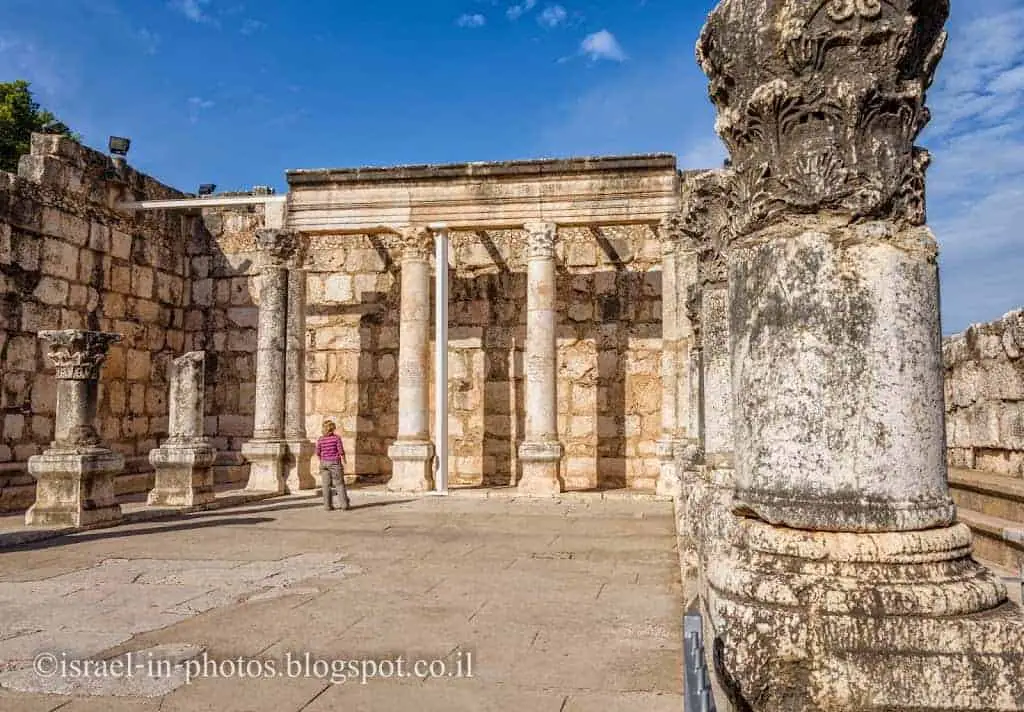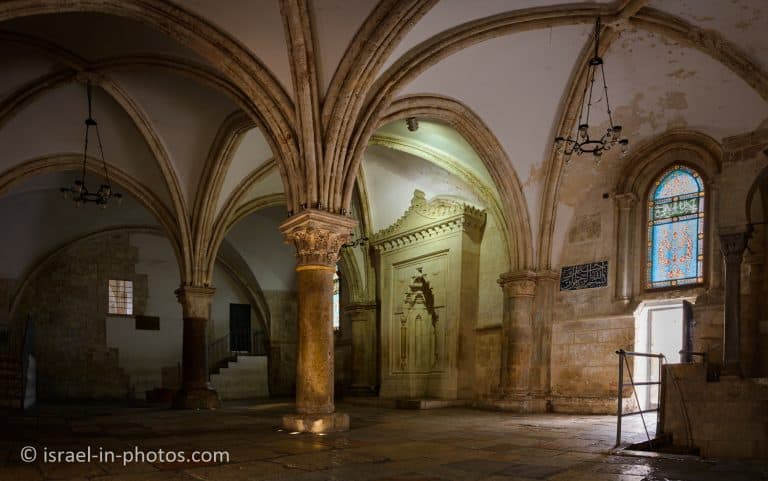Ein Keshatot (Umm el Kanatir), Golan Heights – Visitors Guide
Ein Keshatot (Umm el Kanatir) at Golan Heights is an ancient Jewish village with an impressive synagogue from the Talmudic Period.
Note: After fifteen years of reconstruction and preservation work, towards the end of 2018, Ein Keshatot was reopened to the public.
Table of Contents
Map
Ein Keshatot (Umm el Kanatir) is located at Golan Heights, near Kibbutz Natur and not far from Gamla Nature Reserve.
Directions for drivers: Link to Waze and Link to Google Maps
Directions for public transport: Link to Moovit
Interactive map of the area:
And here is the map of Ein Keshatot (Umm el Kanatir):
Note: you can click on the map to enlarge it.
Walking Path
As you can see on the map, the parking is at the bottom of the image, and from there, you can take one of the two trails. The blue pedestrian path is about an hour loop trail across all points. And the orange is a wheelchair-accessible route.
Directions
If you are reaching by car, enter “Ein Keshatot” into Waze or Google Maps, which will take you to the free parking lot.
And if you are using public transport, you can take bus #51 from Haifa to Natur. And then walk about 3 km to the entrance. Here is the updated link to Moovit. Enter your starting point, and you will get the updated directions.
Opening Hours
March to October:
Sunday to Thursday: 9:00-17:00
Friday and eve of holidays: 9:00-16:00
Saturday: 9:00-18:00
November to February:
Sunday to Thursday: 9:00-16:00
Friday and eve of holidays: 9:00-15:00
Saturday: 9:00-16:00
Entrance Fee
The entrance fee is 25 NIS per adult and 15 NIS per student, elderly, and child (above five years old).
Note: opening hours and ticket prices were updated in October 2021. In any case, recheck the official site before visiting.
Tours
During our visit, there were free tours (included in the entrance fee) every round hour. Thus I would suggest checking out this option.
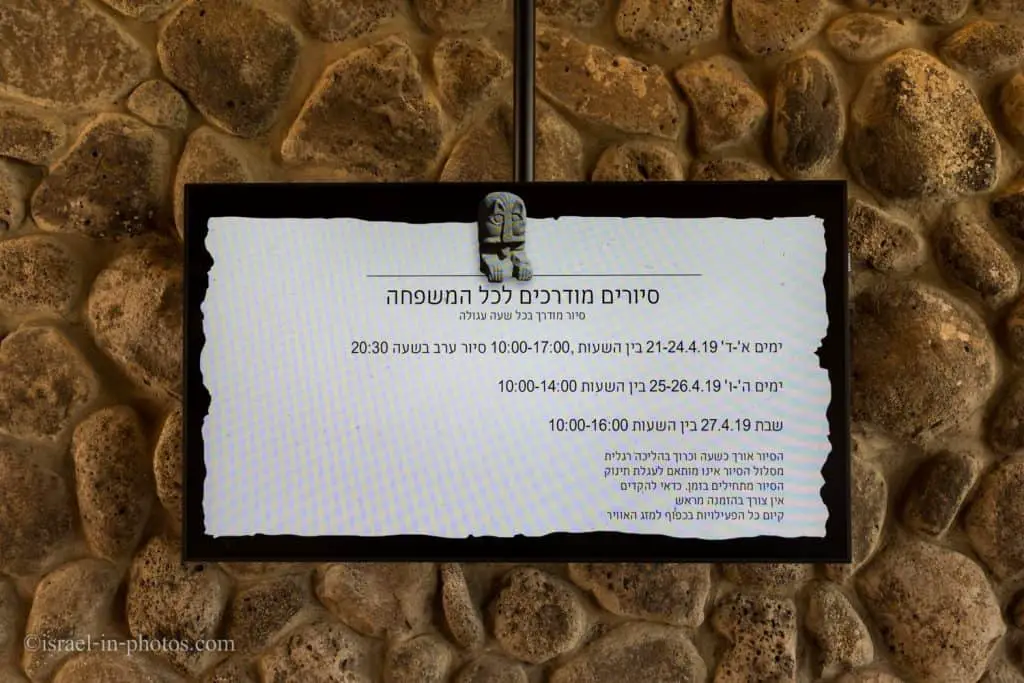
What Do Ein Keshatot and Umm el Kanatir mean?
The literal translation of Ein Keshatot from Hebrew means “Spring of the Arches.” And Umm el Kanatir in Arabic means “the Site of the Arches.” But unfortunately, we do not know the original name of this village. Read on to find out why.
Preserving Names
Most of the names of the ancient Jewish communities in the Golan have been preserved, thanks to the local Arab inhabitants who heard the village names from their parents and elders and continued using them. It is true throughout Israel, too. For example, once known in Arabic as Beisan, the village preserved the ancient city’s name known in Hebrew as Bet Shean. The Arab village of Ein Shams kept the name of the Biblical city of Bet Shemesh.
Note: unless stated otherwise, all quotes were taken from the official site.
Why was the name forgotten?
The village’s basic condition to keep its ancient name is continuous habitation in the village throughout the ages. But in the central Golan, there were hundreds of years during which there were no real communities. From the 8th century CE, an earthquake destroyed the ancient villages until the 13th century CE. Over this period of hundreds of years, the ancient names were lost!
Since the 19th century, the ancient Jewish villages were given Arabic names by the local population who did not know the old local Hebrew names. And so we find an ancient synagogue in a village known as “Katzrin,” which means “fort” or “stronghold” in Arabic. There are also synagogues in Achmediya, Asaliya, and Dabiya – all Arabic names.
Even “Yehudiya” – an ancient Jewish village near a popular hiking trail – is an Arabic name given by locals centuries after the Jews were gone. They assumed that the ancient ruins they saw were from the time Jews inhabited the village.
From Um el-Kanatir to Ein Keshatot
The synagogue at Ein Keshatot was discovered in the late 19th century by a Scottish traveler named Laurence Oliphant. In his day, the local Bedouins called the spring near the synagogue “Um el-Kanatir,” which means “the Site of the Arches.” They chose this name due to the impressive stone arches built above the spring in the Roman period.
When Rehavam Ze’evi (Ghandi) was Israel’s Minister of Tourism in 2001, he initiated the beginning of the ancient synagogue excavation.
Shortly afterward, he was murdered by terrorists in Jerusalem. As a way of commemorating him, the site was renamed “Keshatot Rehavam” (“Rehavam’s Arches”). This name was not authorized by the Israel Government Names Committee, which chose instead “Ein Keshatot” (“Spring of the Arches”) due to the unique stone arches that stand over the spring.
What about the ancient name of the village? The name “Um el-Kanatir” is a relatively modern Arabic name for the site, and unfortunately, we do not know the original name of the ancient village.
History
Ein Keshatot (Um el-Kanatir) is an archaeological site that has been recognized as a National Heritage Site and is located in the southern Golan, near Moshav Natur. At the site, remnants of a Jewish village were discovered and an impressive synagogue from the Talmudic Period.
It is one of about 30 Jewish villages in the Golan during the Talmudic Period, which was a period of significant growth in the area. The synagogue building was constructed in the 6th century CE (approximately 500 years after the destruction of the Second Temple) and was the center of local communal life. It served as a place for prayer, reading of the Torah, and various public activities. A powerful earthquake in 749 CE destroyed the building and the entire village, which was never rebuilt until recent times.
The excavation and subsequent reconstruction of the synagogue took 15 years to complete and included cutting-edge technology. After the stone-by-stone reconstruction (technically known as “anastylosis”), the synagogue stands today at the height of one story. Hopefully, one day, the synagogue will return to its past glory and will be reconstructed to its previous height of two stories.
The synagogue’s excavation and reconstruction were initiated by the Golan Regional Council and archaeologists Professor Chaim Ben David and Ilana Gonen and carried out by Yehoshua Dray, an ancient technology restoration expert.
The Golan Economic Development Corporation manages this site. It offers an experiential visit with a breathtaking cliff-top view towards the Samekh Riverbed and Lake Kinneret from an impressive entrance hall. This movie explains the restoration process of the 1500-year-old synagogue. And a walk through remnants of the ancient village, featuring the Spring of Arches and the unique synagogue.
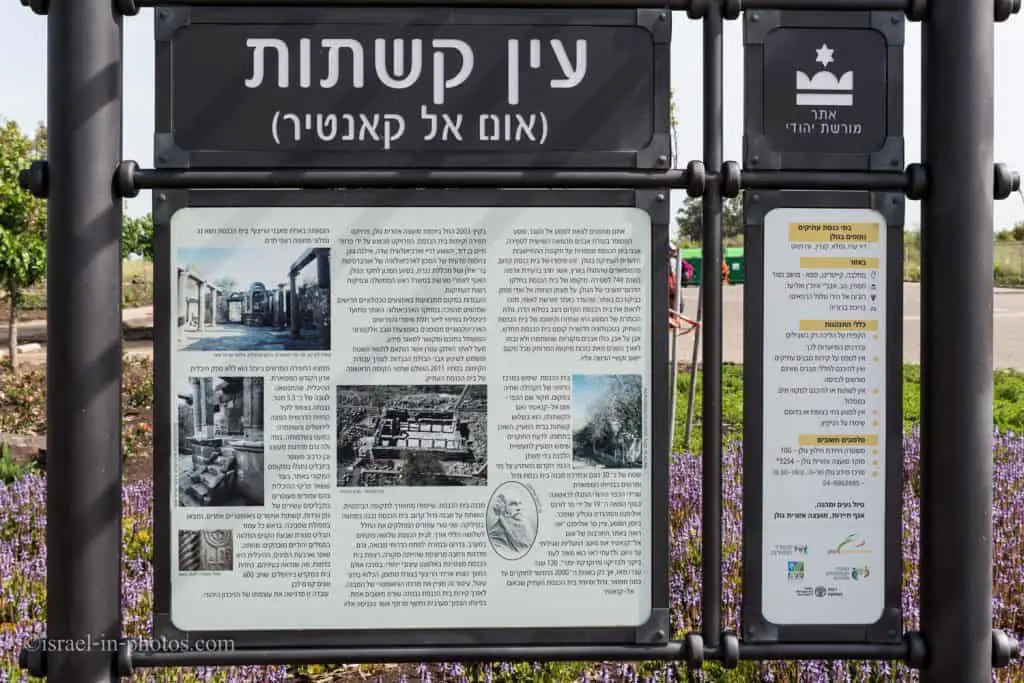
The Galilee Earthquake – 749 CE
The 749 Galilee earthquake destroyed not only Ein Keshatot but many other cities. For example, Beit Shean, Tiberias, and Susita.
Events
If you are interested in holding a small event in the Golan area, this may be the place for you. Here is a short extract from the official site.
A guided tour of the magnificent synagogue, as well as hearing the fascinating story of Ein Keshatot, can infuse your event with added value and add a special touch to your celebration.
For details, and to arrange an event, please call: 050-6912425
Bar/Bat Mitzvahs, Weddings, Events.
Visitors Center
After going through all the essential info, let’s start touring Umm el Kanatir. And we will start our visit at the visitor’s center (point of interest #1 on the map).
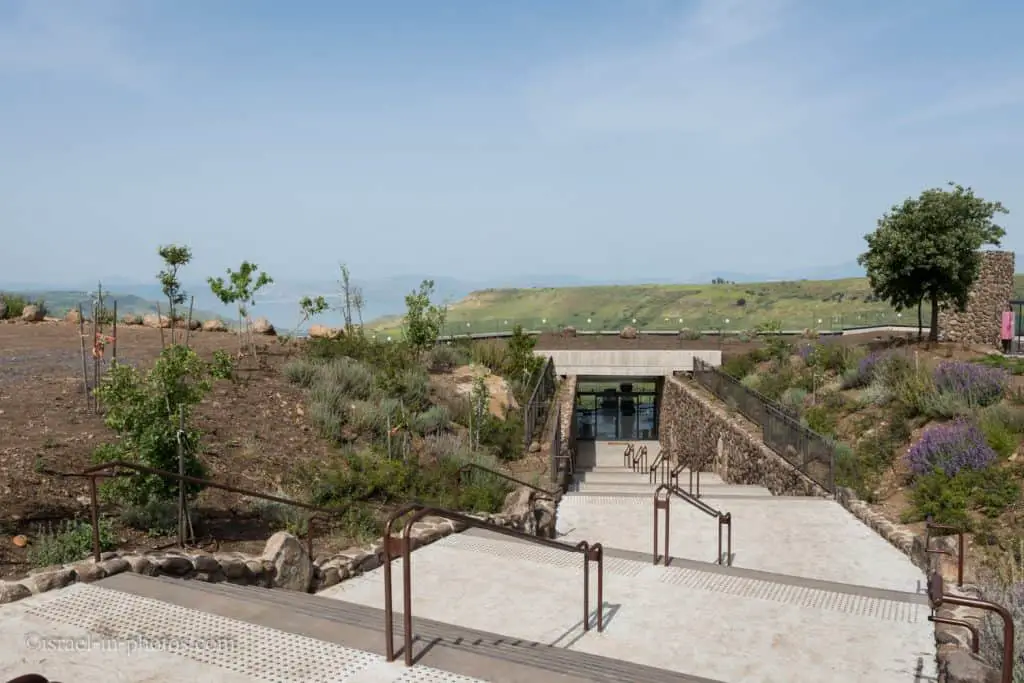
At the entrance hall, we bought tickets and were told that a tour was about to begin. Thus, while waiting, we checked out a small exhibit of archaeological items.
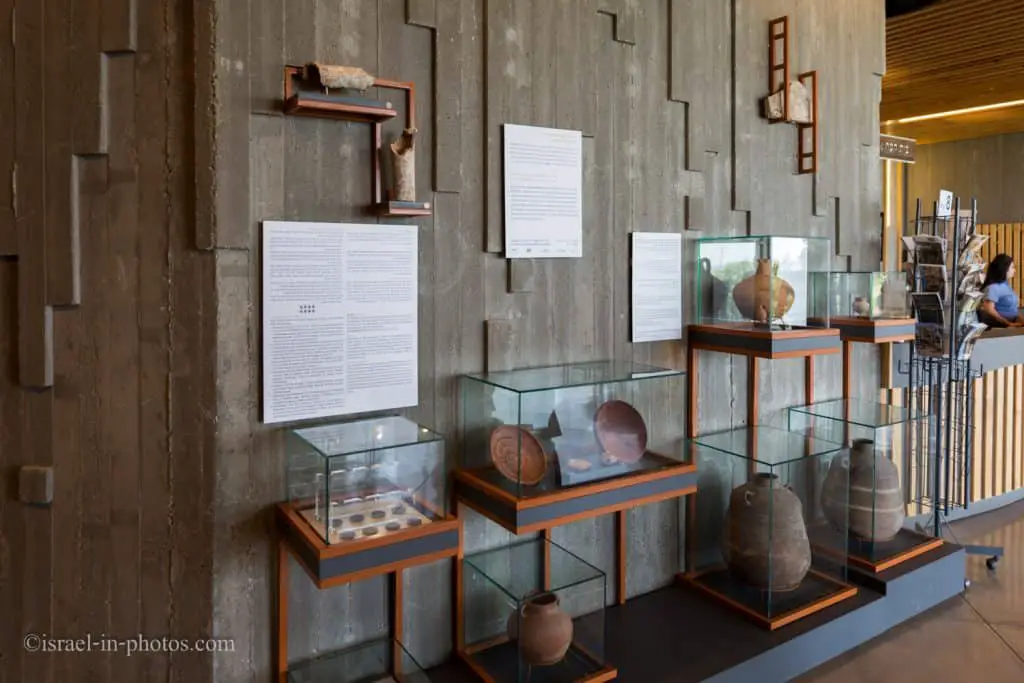
The entrance hall offers a lovely view of the Golan heights. You can see not only this site but you can also see the Sea of Galilee. Here is a panorama that I shot from there.
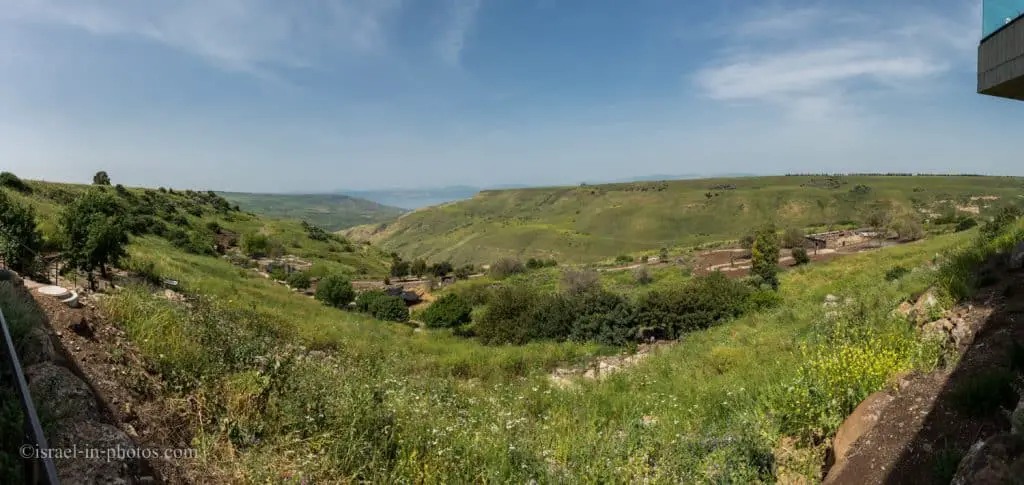
We started our tour by watching a short movie about this site and the synagogue’s reconstruction.

After the movie, the guide joined us, and we walked toward Arches Spring.

As you can see, there are active archaeological excavations at Ein Keshatot. Moreover, sometimes (usually during holidays), they even organize archaeological experiences where families can come and dig. Similar to the sifting project at Tzurim Valley National Park.
The signs on site are both in English and Hebrew.
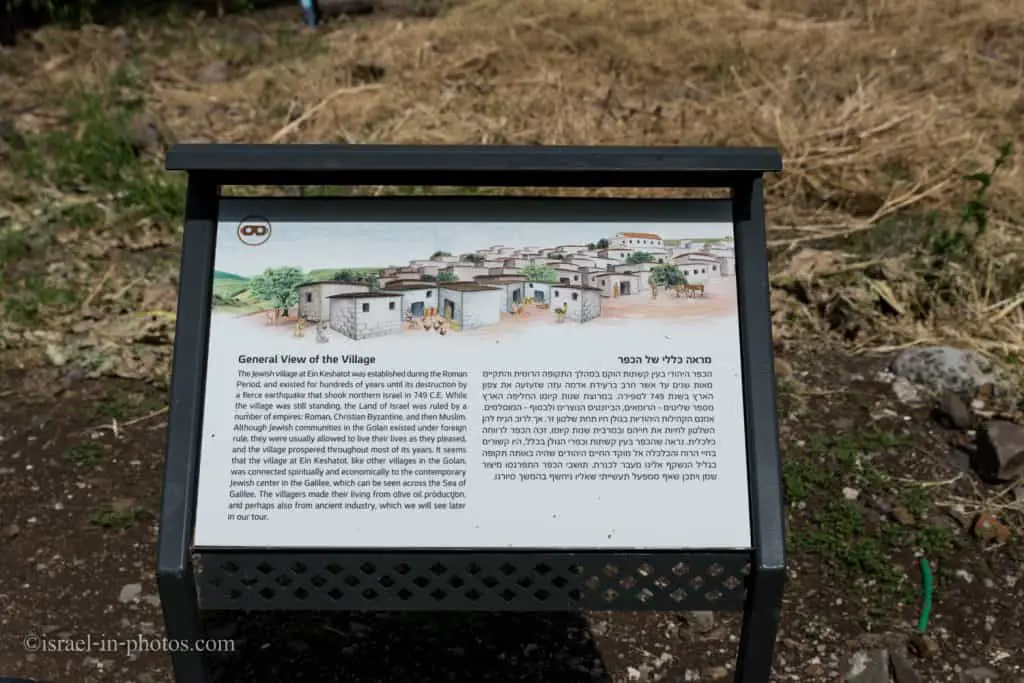
Arches Spring
Many springs can be found in the Golan Heights. Ancient villages were built near these water sources, which were the source of life for local communities.
During the Roman period (3-4th century CE), impressive stone arches, a pool, and a series of channels were installed in the spring.
Among the rural villages of the Land of Israel, this is the most unique and exclusive structure. Who built it, and for what purpose? It could be that the ancient village residents made it, or someone from outside the town donated money for its construction (we know of similar cases in the ancient Roman world). Either way, when the Jewish community members inhabited the village near the spring during the hundreds of years after its construction, they used the structure of the arches and the pool for their own needs.
The name “Urn el-Kanatir” — which means “the site of the arches” —was given to the spring by local Bedouins who were impressed by the monumental arches. Therefore, this is a relatively new name for the site. The village’s ancient name has been lost in history and is no longer known to us.
Source: sign
Note: Arches Spring is the point of interest #2 on the map.
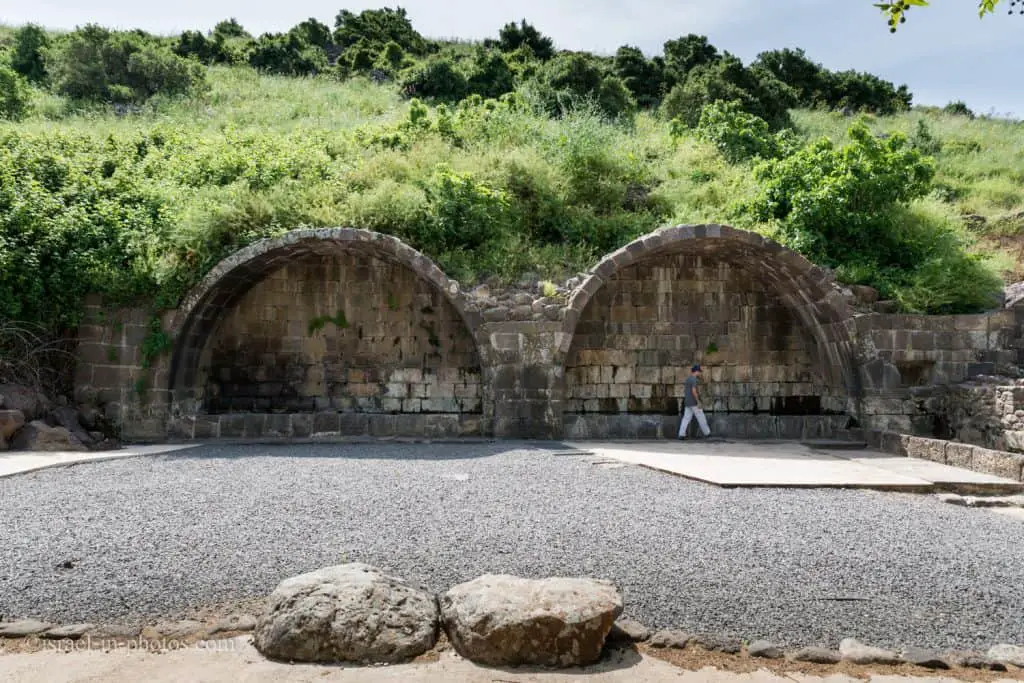
It was not the first time we visited Ein Keshatot. Our previous visit was in 2011, when the synagogue was still under restoration. And here is how the Arches Spring looked then:

The Industrial Area at the Spring
The spring was used not only as a water source but also as an industrial area.
A flax-processing workshop may have existed at the village spring, where white linen clothes were produced.
These garments were delicate and expensive, and only wealthy people could afford to buy them. The stems of the flax plant were soaked in the pools to separate the external skin from the internal fibers, which were then woven into threads and fabrics. Traces of limestone (used to whiten the fabric) were found in the pools. Part of the production process included crushing chalky material; the concave tops of basalt pillars were used as the crushing surfaces.
“Rabbi Yochanan said: If one is left a fortune by his parents and wishes to waste it, he can wear linen garments, he can use glassware, and he can hire workers but not stay with them when they work.” (Babylonian Talmud, Baba Metzia 29b)
Source: sign

Since there was an industrial area, there was also a trade of goods. Tiberias is a nearby central city. They probably traveled there using boats from the port of Gergesa, also known as Kursi.
Synagogue
We continued to the ancient synagogue (point of interest #3 on the map).
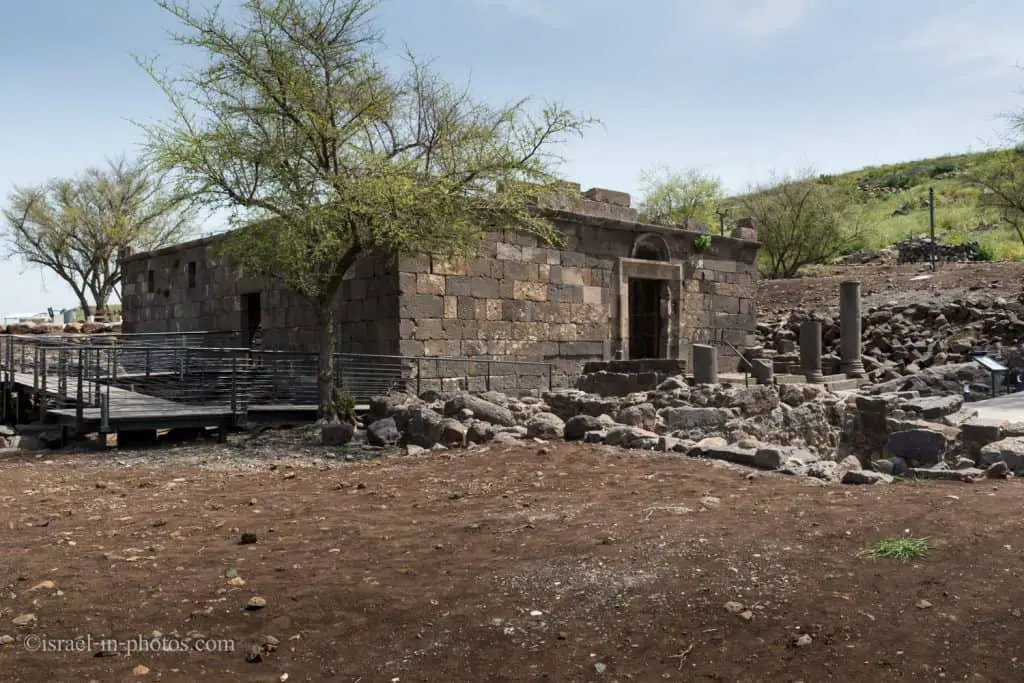
We can see that the local residents invested massive financial resources and energy in its construction. Such a magnificent building must have required substantial funding, the source of which was the local olive oil production and – perhaps – an industry near the spring.
The building was erected in the 6th century CE (approximately 500 years after the destruction of the Second Temple) and was the center of communal life. It was here that prayer, Torah reading, and other public activities were regularly conducted.
A violent earthquake in 749 CE destroyed the structure and the entire village, which was left abandoned until modern times.
Source: sign
As you enter the synagogue from the side entrance, you will see that it was built on top of another building.


The Synagogue Facade
Like many of the contemporary synagogues in Galilee, the entrance to the synagogue at Ein Keshatot is located in the south, which seems to have been a local tradition.
A covered patio was built at the entrance, and its roof was supported by four pillars, whose pedestals were incorporated into the staircase. Notice the predatory scene engraved into one of the pedestals: a lion devours an animal, and a rooster is watching from the side. This engraved column base was probably borrowed from an earlier structure and incorporated into the synagogue when it was constructed. It was covered in plaster and built into the staircase, so the village residents could not have seen it.
Source: sign on site

The Torah Ark Complex
Let’s enter the synagogue and see one of its most impressive features, the Torah Ark.
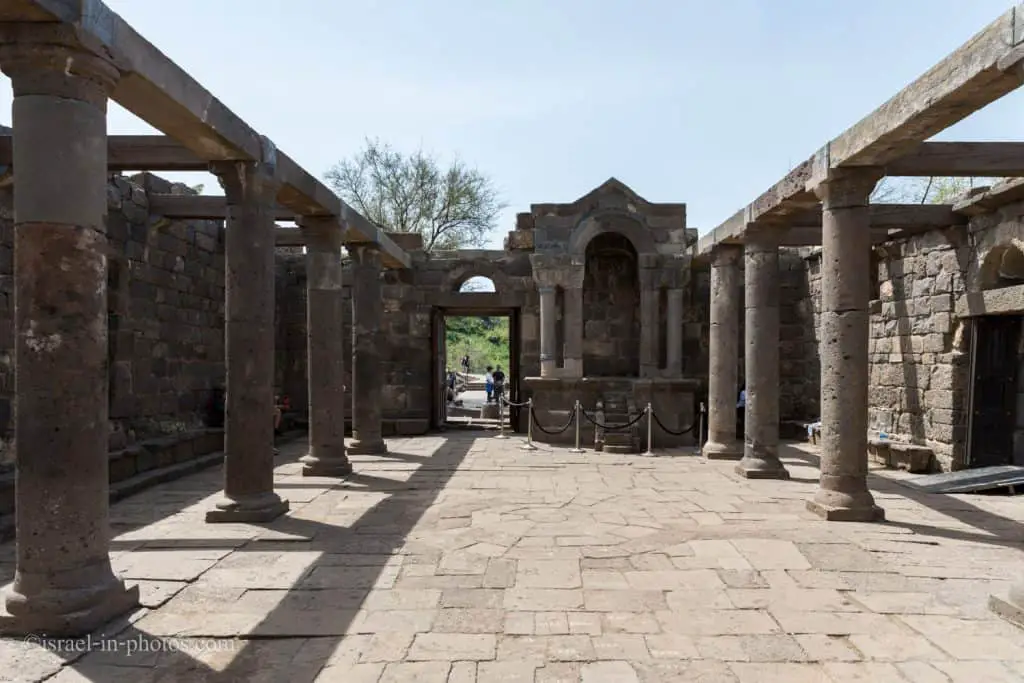

Notice the most unique and decorated part of the building: the stone structure that stood over the ark of the Torah.
The ark itself, which housed the Torah scrolls, was apparently made out of wood and did not survive. But the stone ark complex was remarkably well-preserved, and the artistic stone engravings are especially impressive.
Most of its parts collapsed due to the earthquake that toppled it. Still, the engraved decorations were left intact, and they reveal the high quality of the artists’ elaborate work.
The Torah ark complex was designed to resemble the facade of the Temple in Jerusalem and was decorated with several Temple motifs. Hundreds of years after the Temple was destroyed, the Jews still honored its memory when building their magnificent synagogues.
Source: sign
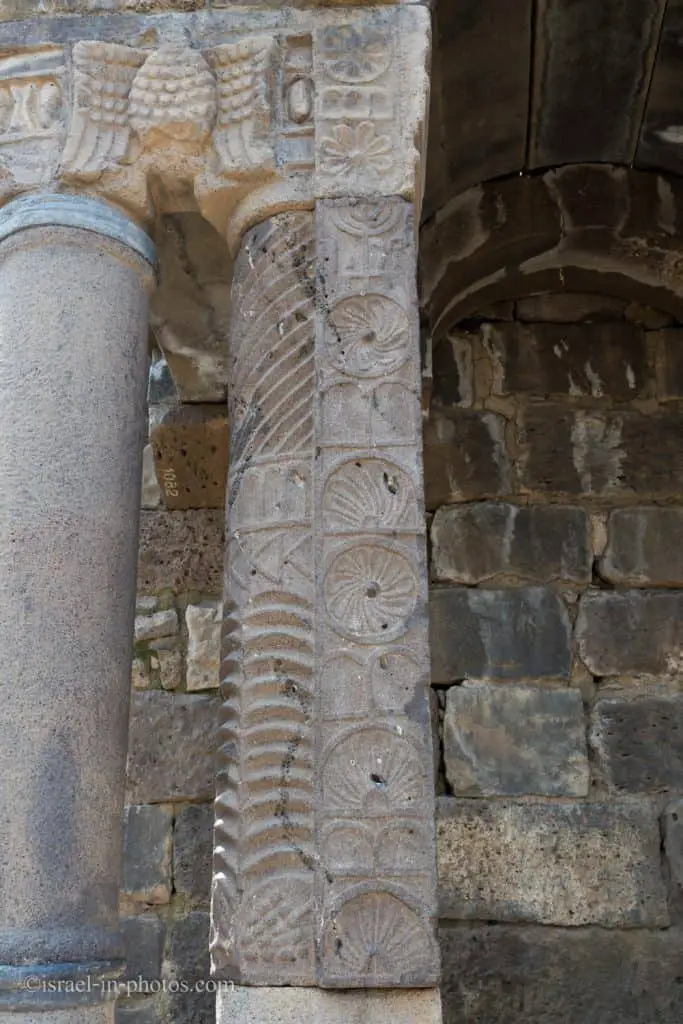
Olive Oil Press
And the last stop of our tour was the olive oil press (point of interest #4 on the map).

We can see the basalt crushing-basin, which was used in olive oil production.
During the Roman and Byzantine Periods, the Jewish villages were located in the central area of the Golan, which has rocky basalt-based soil that is difficult to cultivate. Olives were one of the few crops suitable for this region. Many oil presses have been discovered in the central Golan.
Some of the olive oil produced in these presses was consumed locally, and some were sent in caravans of camels and donkeys to the nearby Bashan and Horan regions.
Source: sign
And that was the end of our tour. It lasted for about an hour, and we enjoyed it a lot. Our guide was friendly and knowledgeable and told us many interesting things.
Summary
If you visit the Golan Heights or the Sea of Galilee, consider visiting Ein Keshatot (Umm el Kanatir). We enjoyed our visit, and if you can join a tour, I recommend doing so. Additionally, if you love digging and sifting, check if there is an archaeological experience soon.
Have you ever been to Ein Keshatot? Tell us about your experience in the comments below.
That’s all for today, and I’ll see you in future travels!
Stay Tuned!
Additional Resources
Here are several resources that I created to help travelers:- Trip Planner with Attractions and Itineraries is the page that will help you create your perfect travel route.
- What is the Best Time to visit Israel? To answer this question, we will consider the weather, prices, holidays, festivals, and more.
- Information and Tips for Tourists to Israel will answer the most common questions tourists have about Israel (including safety, passports, weather, currency, tipping, electricity, and much more).
- Israel National Parks and Nature Reserves include a complete list, top ten, map, tickets (Israel Pass, Matmon, combo), and campsites.
- If you are looking for things to do, here are the pages for Jerusalem, Tel Aviv, Haifa, Sea Of Galilee, Akko (Acre), Eilat, Nazareth, Safed (Tzfat), and Makhtesh Ramon.






